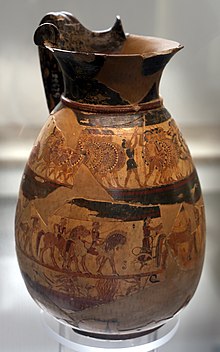
Back Ваза Кіджы Byelorussian Chigi-Kanne German Αγγείο Κίτζι Greek Olpe de Chigi Spanish Olpé Chigi French Chigi-váza Hungarian Olpe Chigi Italian Вазна Киѓи Macedonian Waza Chigi Polish Киђи ваза Serbian
| Chigi vase | |
|---|---|
 Hoplites on the Chigi vase | |
| Material | Clay |
| Height | 26 cm |
| Created | c. 645 BC |
| Discovered | 1881 Italy |
| Present location | Rome, Lazio, Italy |
The Chigi vase is a Proto-Corinthian olpe, or pitcher, that is the name vase of the Chigi Painter.[1] It was found in an Etruscan tomb at Monte Aguzzo, near Veio, on Prince Mario Chigi’s estate in 1881.[2] The vase has been variously assigned to the middle and late Proto-Corinthian periods and given a date of c. 650–640 BC;[3] it is now in the National Etruscan Museum, Villa Giulia, Rome (inv. No.22679).
The vase stands 26 cm (10.2 inches) tall, which is modest compared to other Greek vases.[4] Some three-quarters of the vase is preserved. It was found amidst a large number of potsherds of mixed provenance, including one bucchero vessel inscribed with five lines in two early Etruscan alphabets announcing the ownership of Atianai, perhaps also the original owner of the Chigi vase.[5]
- ^ Amyx 1988, 31–33, and Benson, Earlier Corinthian Workshops, 1989, 56–58, call the artist the Chigi Painter. However, Dunbabin and Robertson, "Some Protocorinthian Vase Painters", Annual of the British School at Athens, 48, 1953, 179–180 favour the appellation "Macmillan Painter".
- ^ Ghirardini 1882, p. 292.
- ^ Hurwitt, p. 3, note 12, lists the competing views on the date.
- ^ Hurwit, Jeffrey M. (2002). "Reading the Chigi Vase". Hesperia: The Journal of the American School of Classical Studies at Athens. 71 (1): 1–22. doi:10.2307/3182058. JSTOR 3182058.
- ^ Hurwitt, 2002, p. 6.
© MMXXIII Rich X Search. We shall prevail. All rights reserved. Rich X Search